Huong, 15, competes at the Golden Gate Science Olympiad in Air Trajectory, which requires a build that uses the gravitational potential energy of a falling weight to launch a ping pong ball at a bucket some distance away. She is the only girl in a crew with three older male teammates.
Huong says she has learned much from them, especially applying physics and math theory to their builds. At first, however, “it was walking into a room with guys and their hammers and drills doing all the engineering, like girls aren’t meant for this,” she says. “But then I went home and designed the weight system that we now use. Solving the problem that men are supposed to do motivated me.”
Huong is a member of the Milpitas High School Science Olympiad team outside of San Jose, California. It was founded in 2008 by Letta Meyer, the school’s AP chemistry and forensics teacher. Meyer had heard about the competition along with one of her students, and they decided to start up a team from scratch. Since then, more than 300 students have been Milpitas High Science Olympians.
Science Olympiad is an extracurricular science, technology, engineering and math (STEM) competition involving some 7,800 high and middle school teams across the United States. Tournaments are organized like track meets, where a team of up to 15 students compete, mostly in pairs, across 23 science events like Astronomy, Microbe Mission, Flight, Codebusters and Robot Tour. These events are written tests, physical labs, engineered builds and hybrid activities combining these different elements. The competitions are only a small part of the overall activity, as team members spend an average of between six and 10 hours a week throughout the year studying, soldering, prototyping, logging, catalyzing, memorizing, constructing, programming, analyzing or whatever it takes to succeed in their events.
One of Meyer’s aims with the team is to attract more girls into STEM. A first-generation college graduate, she remembers roadblocks to girls growing up in the 1990s, like being urged to prioritize getting married and having kids over seeking education. She was good at math and was planning to study accounting like her older sister. Then she took a general science class for non-majors. There, seeing a demonstration of igniting hydrogen and oxygen in a balloon to form water led to a fascination with science that she continues to share with her students today.
In 2023, noting the persistent underrepresentation of women in STEM fields overall, especially engineering and technology, Meyer published a case study on the impact of Science Olympiad on female team members’ STEM identity as her doctoral dissertation at the University of San Francisco. She found that participating in this kind of program, which is more collaborative than competitive, allows girls “a safe space to develop STEM identity and personal specific STEM interests.”
These photographs follow the Milpitas High School team through the 2024 Science Olympiad season, with a focus on female students. Their images, views and experiences touch on a number of observations Meyer makes in her dissertation as key to sustaining young women’s sense of belonging in STEM, including:
- participation in a safe space where perfection is not expected
- support for exploring areas outside of one’s comfort zone
- girls and boys collaborating in a community of teammates, partners and role models
- growing competence leading to deeper interest and internal motivation
- confidence and competition readying students for the outside STEM world.
The Milpitas High School Science Olympiad team’s season ended in March, when it came in fifth in the Santa Clara County Regionals, missing qualification for NorCal State Finals by one place. Monta Vista High (Cupertino), the team that won Regionals, went on to win NorCal, and at the end of May won the 40th Annual Science Olympiad National Tournament at Michigan State University.
Brianna, 14, and Darren, 16, set up for Scrambler, where the energy from a falling mass drives an egg-laden vehicle as close to a barrier as possible without cracking the eggshell.
Before middle school, Brianna never thought about science; she was into princesses and unicorns. She was bored by a programming course her software engineer father made her take, and didn’t like the idea of studying for competitive tests outside of school. She did enjoy making things — clay, painting, origami — so on this year’s team she became known as the freshman girl who does builds: Flight, Tower and Scrambler.
“In Sci Oly, you and your partner are on your own, hands-on, no teacher,” she says. “It’s all the test runs and failed trials that make you better. YOLO, right?”
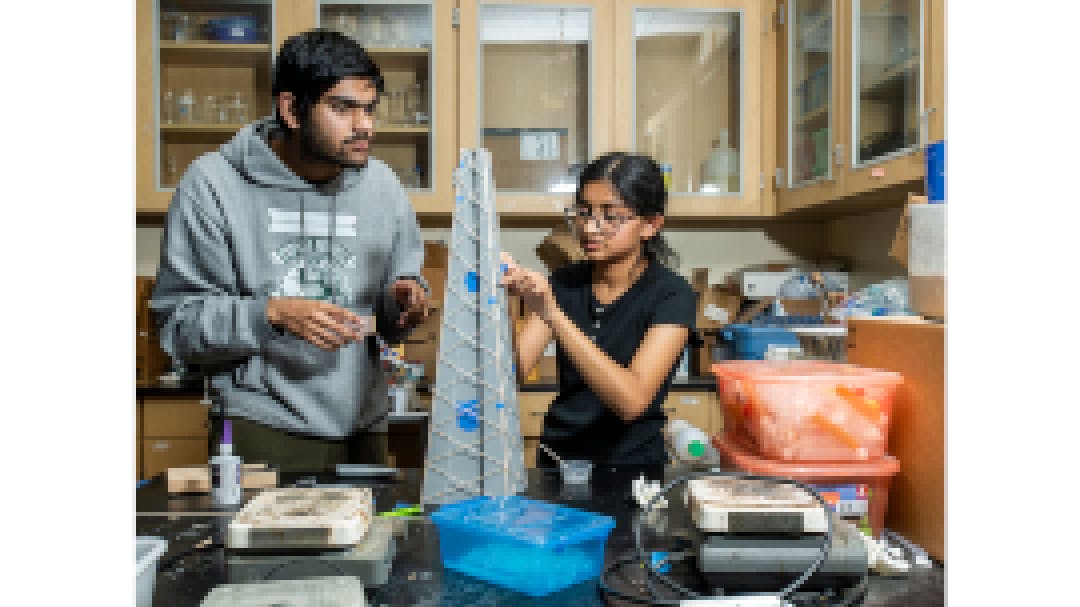
For Tower, Saga, 15, and her partner Sukhad, 18, build a wood and glue structure required to be at least 60 centimeters tall and able to span a 20 by 20 centimeter opening. Points are awarded by dividing the weight the tower can bear (sand in a bucket suspended by a chain) by the weight of the tower itself. Using lightweight balsa, their best tower weighed just 6.2 grams and held over the maximum 15 kilograms of sand. Over three months of testing and competing in the 2024 season, the pair built and destroyed 15 towers.
Saga says, “I had never been extremely competitive. But when I was a freshman, at one tournament in Forestry, we ended up just 0.5 points from sixth place, which is where the medals start. That was it. We started studying like crazy. And the next competition we got third.”
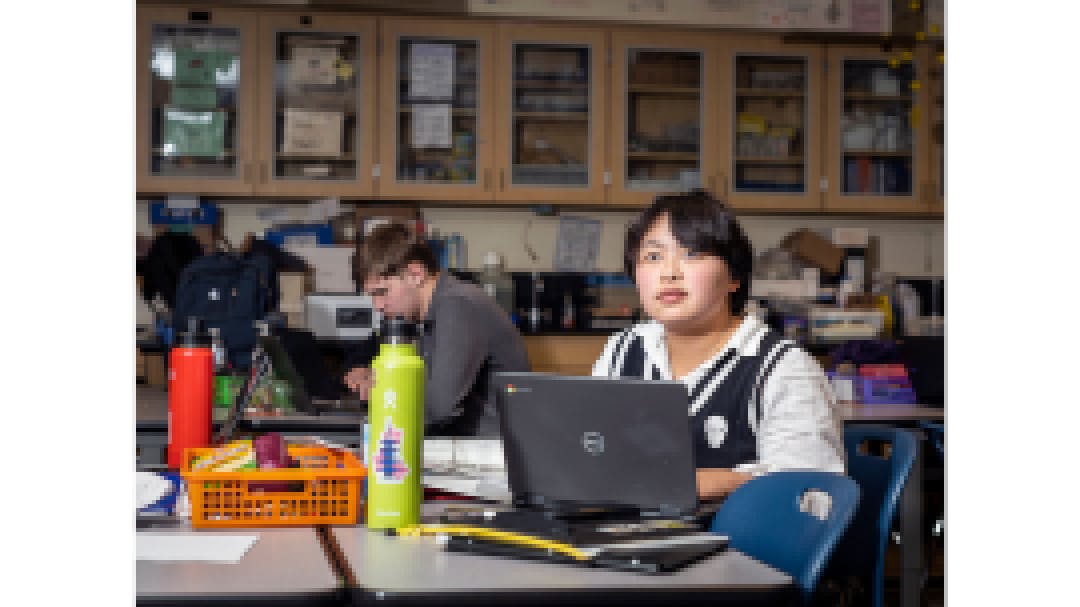
An, 17, studies with her partner, Roman, 17, for Disease Detectives, where competitors apply epidemiology principles to come to conclusions about real-life outbreaks and other public health situations. She compares being part of Science Olympiad to her experience on the school swim team.
“I’m one of the faster girls, so I often train with the guys,” she says. “For a long time, they acted like I didn’t deserve to swim with them. I was on the edge. I felt I had to prove myself.”
The Science Olympiad team, on the other hand, is a “safe, happy, welcoming place,” she says, where she has worked well with male teammates, including a three-year partnership with Roman in multiple events. “Collaboration makes me more confident.”
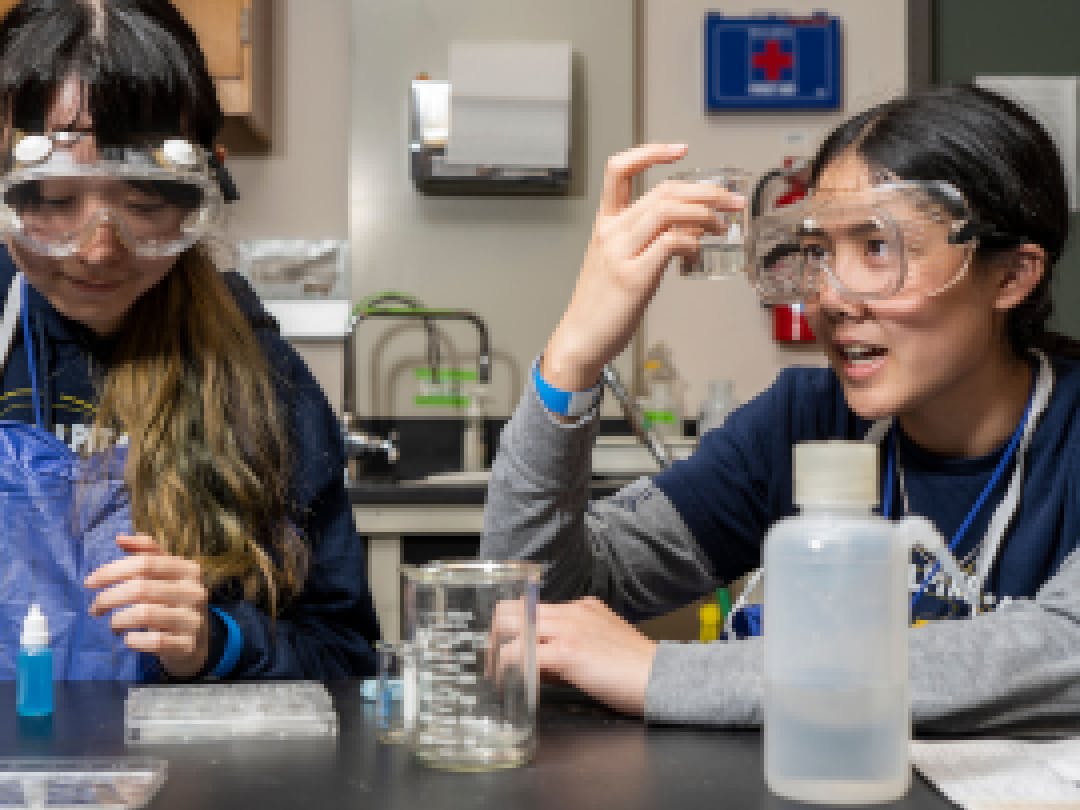
Isabella (right), 14, and Vanessa (left), 16, compete in Forensics at the Golden Gate Science Olympiad at the University of California, Berkeley.
In addition to Science Olympiad, Isabella also competes in basketball, volleyball and track.
“In sports, guys have the biological advantage,” she says. “They are stronger and faster. But intelligence isn’t based on gender. I want to show the world I’m just as smart as any guy. Look at Dr. Meyer. She’s so knowledgeable. If she’s in STEM, I can be in STEM, too.”
When Vanessa joined the team last year, her first feeling was, “oh, these are the smart people.” She doesn’t see herself as a competitive person, but as a relative latecomer to Sci Oly, she was eager to catch up with her teammates. “They are elite, but also down to earth, overcoming the same struggles. So I think, maybe in the future I will be like that.”
She says her father and mother used to be “tiger parents,” strictly managing her and her younger sister to meet high expectations for academic success. Going into COVID-19 lockdown just after moving from Taiwan to the U.S. five years ago, however, changed things. “Spending a lot of time together, we figured out each other’s boundaries.”
Vanessa’s father, a software engineer, has an optimistic practical viewpoint. She says, “He wants me to go into STEM. He says I will have an easier time getting a job because companies are starting to look for more women.”
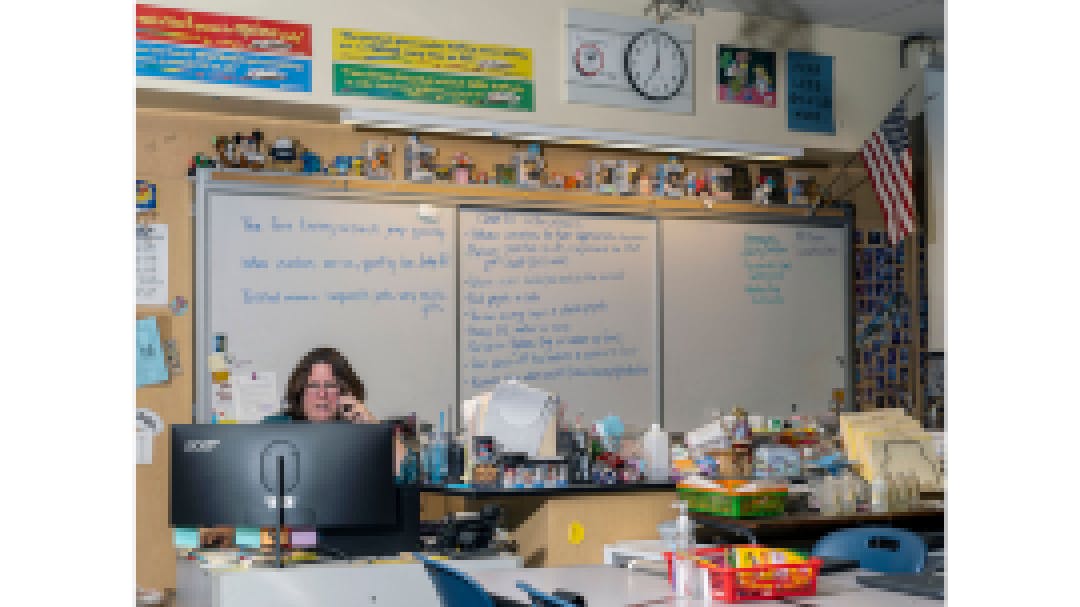
Meyer’s AP chemistry classroom also serves as the Milpitas High School Science Olympiad headquarters. She loves teaching but sees Sci Oly as an opportunity for students to explore and compete.
In her dissertation, she discusses research about girls’ conditioned aversion to competition as a roadblock to success in STEM. She adds, “If there’s no competition, there’s no reason to push further. Without stress, there’s no drive. With too much, though, it’s paralyzing, and we see impostor syndrome, like they don’t belong. So there’s a sweet spot that is different for different girls.”
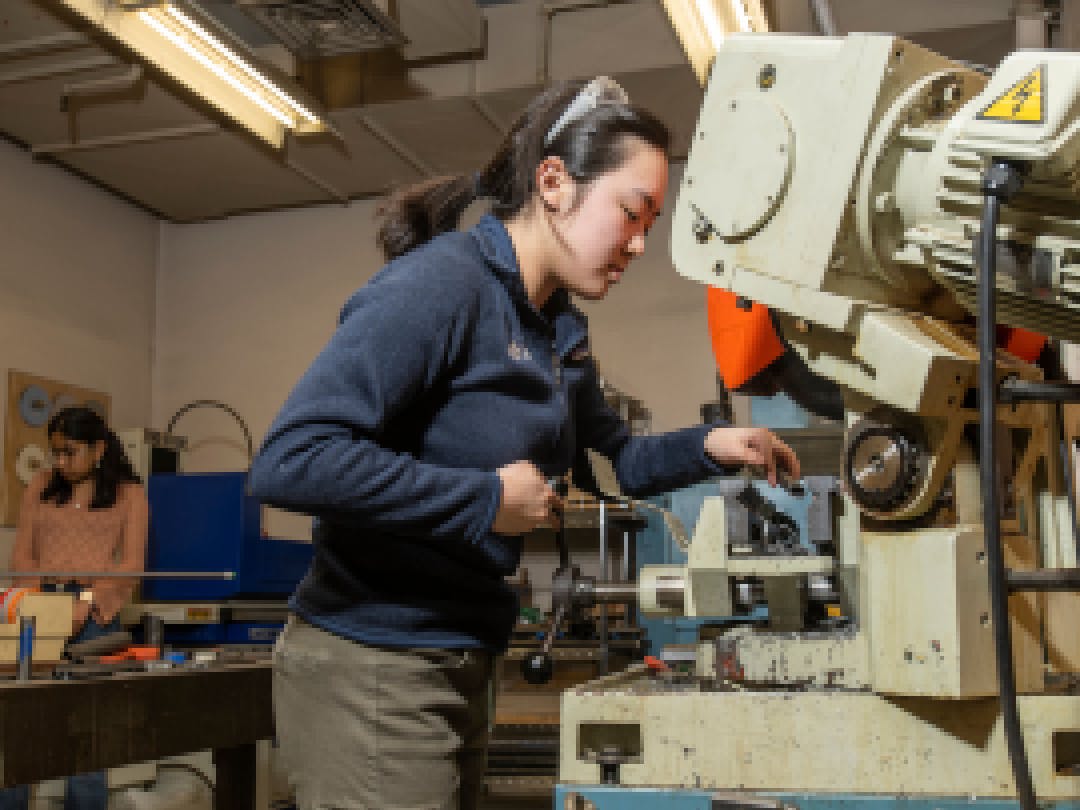
As a Milpitas freshman, Annabelle, 19, wasn’t familiar with Science Olympiad, but she was interested in marine biology and the team “had the word ‘science’ in it,” she says. She started as one of two girls among 15 older boys in Detector Building, where students engineer electronic sensor devices. “I got to see the STEM gap in real life. The guys gathered together and left us out. That experience steered me away from electronics,” she says.
She felt a better fit in lab and test events, where more girls were involved than in the builds. But then she added Bridge (similar to Tower but emphasizing length over height) as a junior. She saw an older female student succeeding there, so she felt less intimidated, and medalled in a number of competitions.
In 2022, she was named a senior captain on a team that reached NorCal State Finals. “Dr. Meyer prepared us to diversify and make everyone feel included. We decided to encourage more girls to participate in the builds, to show that they can do very well and also help males learn how to collaborate with females,” Annabelle says.
Bridge pushed Annabelle out of her comfort zone and, along with a growing interest in environmental sustainability, made her decide to major in civil engineering at the University of California, Berkeley, where she is also learning to machine and weld parts for a much larger structure as part of the university’s Steel Bridge Team. In engineering, she feels women often have to be more extroverted and aggressive to be heard. But she says, “I am glad I made this choice.”
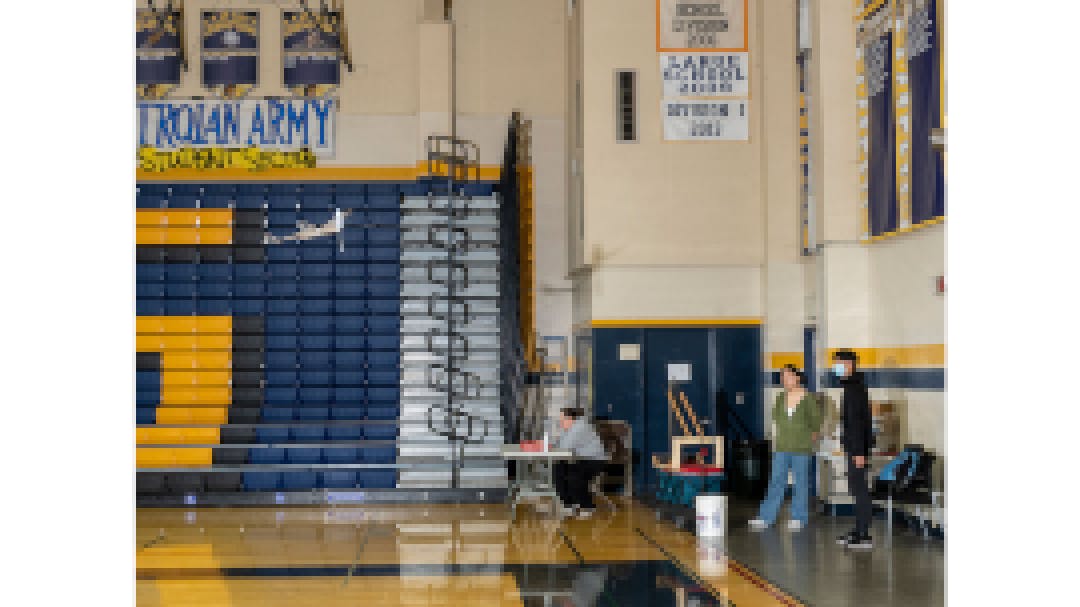
Brianna, 14 and Darren, 16, practice with their rubber band-powered, mylar-winged airplane for the Flight event, where teams place higher the longer their aircraft stays aloft.
Meyer sits nearby, but the students cover virtually all of the design, planning and decisions. They don’t get to practice much because Flight requires a big indoor space, and the gym is usually in use by the sports teams.
The partners decided to work together on both Flight and Scrambler because each of them could take charge of building one thing: Brianna the plane and Darren the vehicle. He says, “I am most interested in everyone having an equal amount of responsibility. Yes there is systemic sexism, but I’m not looking at gender. I just want to see what my teammates can do.”
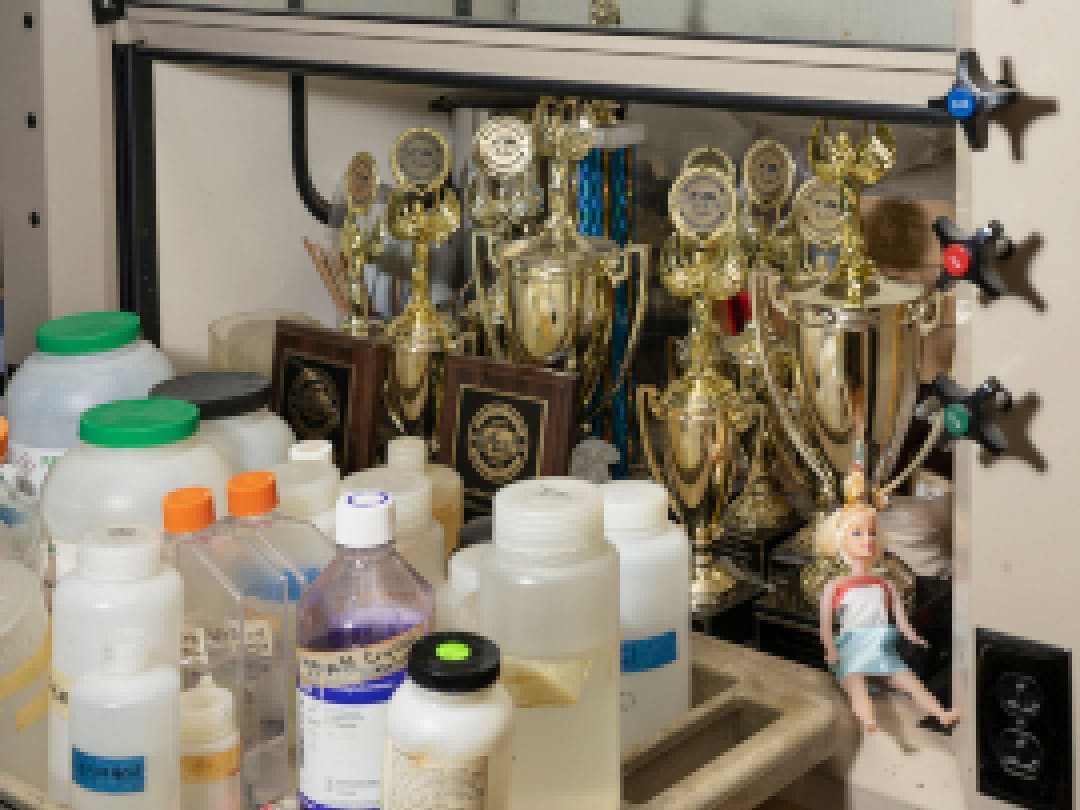
Trophies the team has won in competitions get stashed in various corners of Meyer’s chemistry classroom, including the laboratory fume hood. This reflects the way students view the awards: in the moment, they affirm their abilities, serving as extra confidence boosters and a means of measuring effort and accomplishment. In the end, however, they become a minor part of the team experience. Saga says “The joy of medalling lasts about 15 minutes, but the whole thing is so much fun.”
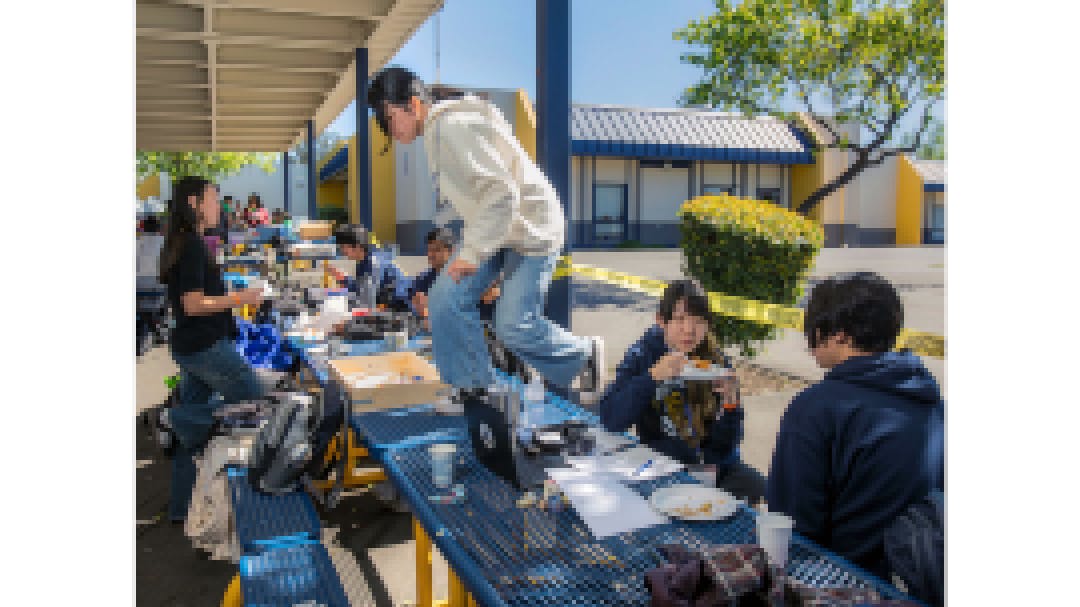
Between events at the Santa Clara County Regionals, team members prepare, eat, do homework, rest and socialize. Brianna jumps over the table while Vanessa (facing camera) has lunch while chatting with a teammate.
Vanessa says, “We bond over science, and that becomes friendship. Being partnered with males starts out differently than with females. It’s a little awkward, a bit more formal. The turning point is after we’ve taken one official test together. When we come out, we just feel relief and all the tension is gone. We look at each other and say ‘It’s over. Let’s go eat.’”
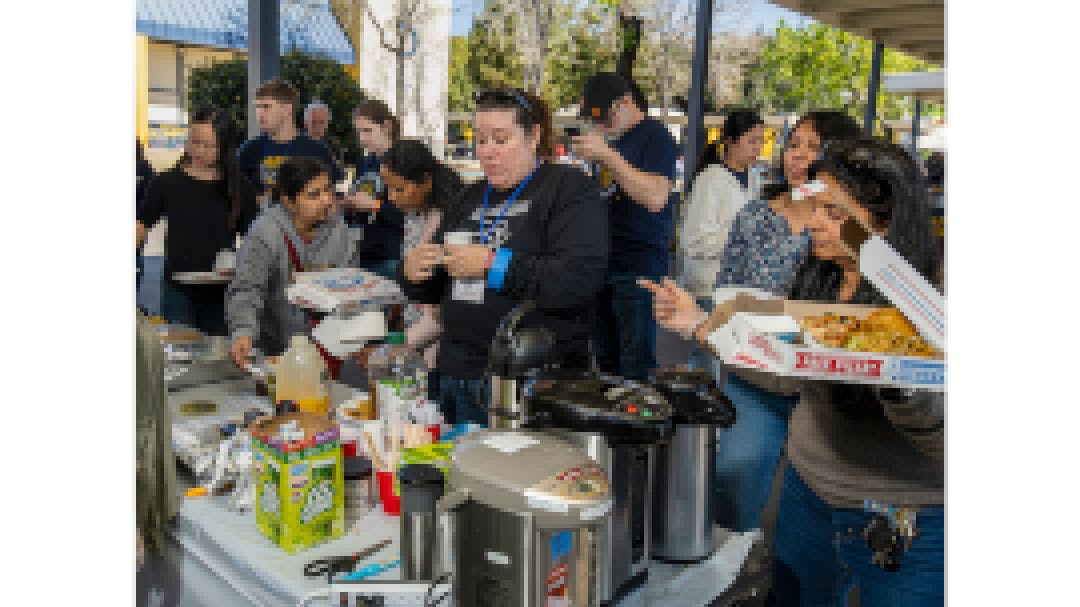
At the Santa Clara County Regionals (which were hosted this March by Milpitas High), Meyer grabs a quick bite at the team table, run by parent volunteers supporting the students. There are 40 high school and 27 middle school teams in the competition. Milpitas has 60 students present: three teams plus alternates.
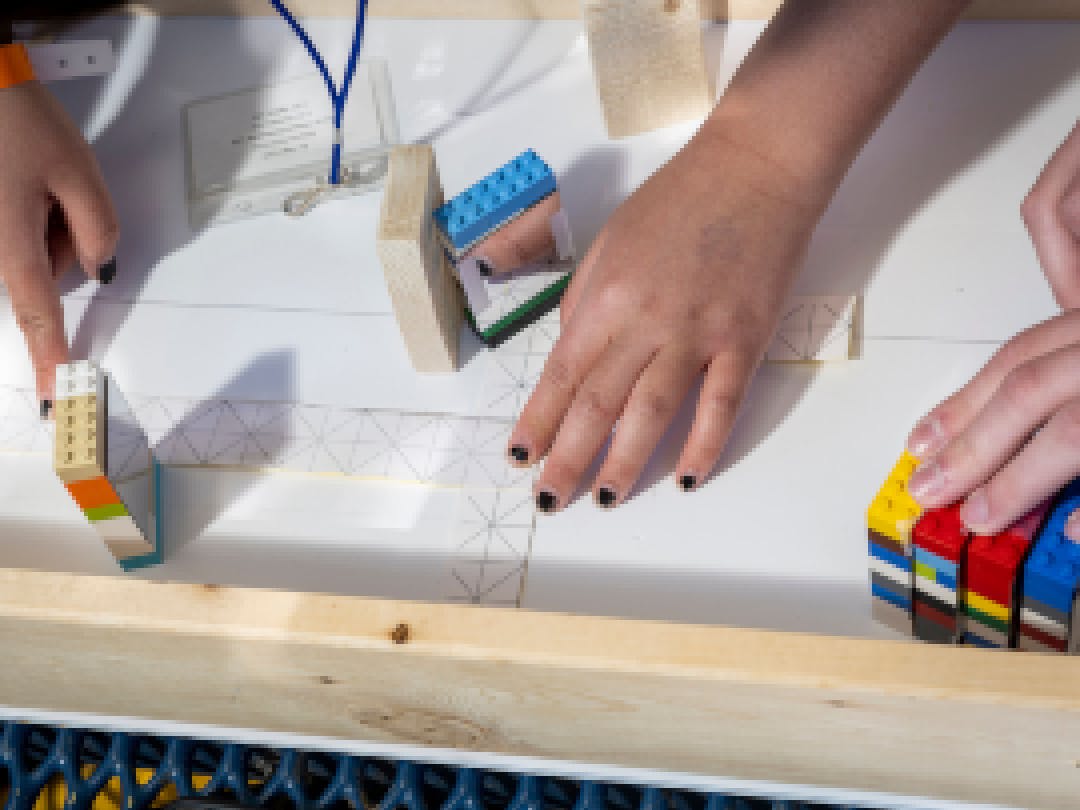
An and Roman practice scenarios for Optics, where they use mirrors to guide a laser beam through a box-field of obstacles.
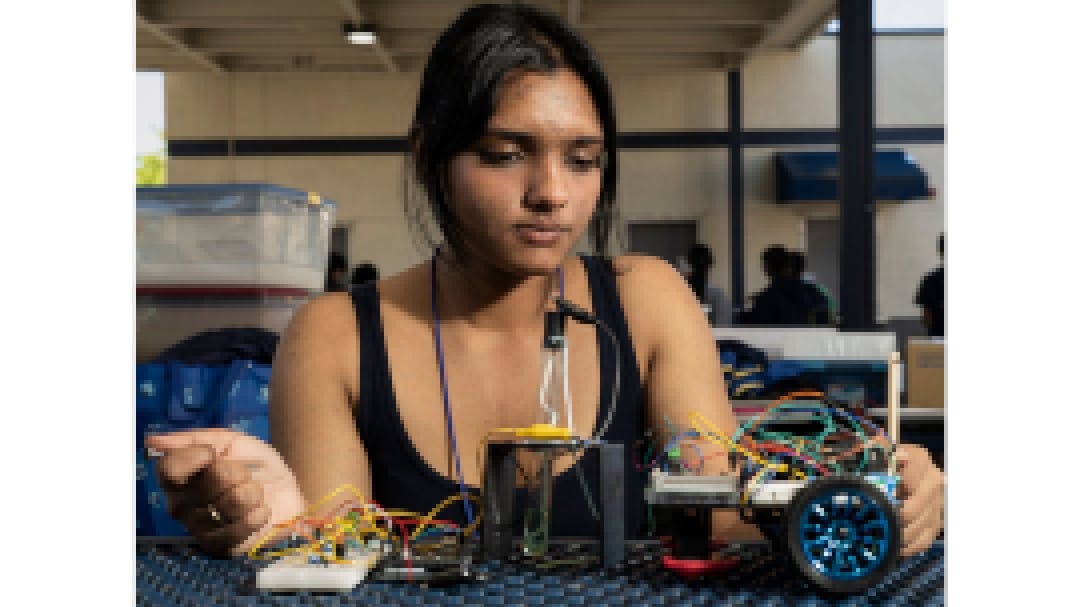
Ananya, 16, shows devices she engineered with her partners for Detector Building and Robot Tour. She enjoys the hands-on approach to specific problems. She also enjoys improvising solutions. Discussing their Detector, an electronic probe that measures concentration and voltage of salt solutions, she says, “At Regionals we had one minute to do the last reading. But the piece of zinc that goes into the solution came unsoldered from the wire, so the reaction wasn’t happening and we were kind of screwed. Then I told my partner to put his finger in there to complete the circuit and it worked. We even medalled!”
Working with circuits has overlapped in other interests, such as building an electric guitar to play in her indy band. She sees a lot of similarities as a girl in music and STEM: “It’s OK to be wrong. Everyone’s on the same footing. It’s OK to take up space — speak up and be heard.”
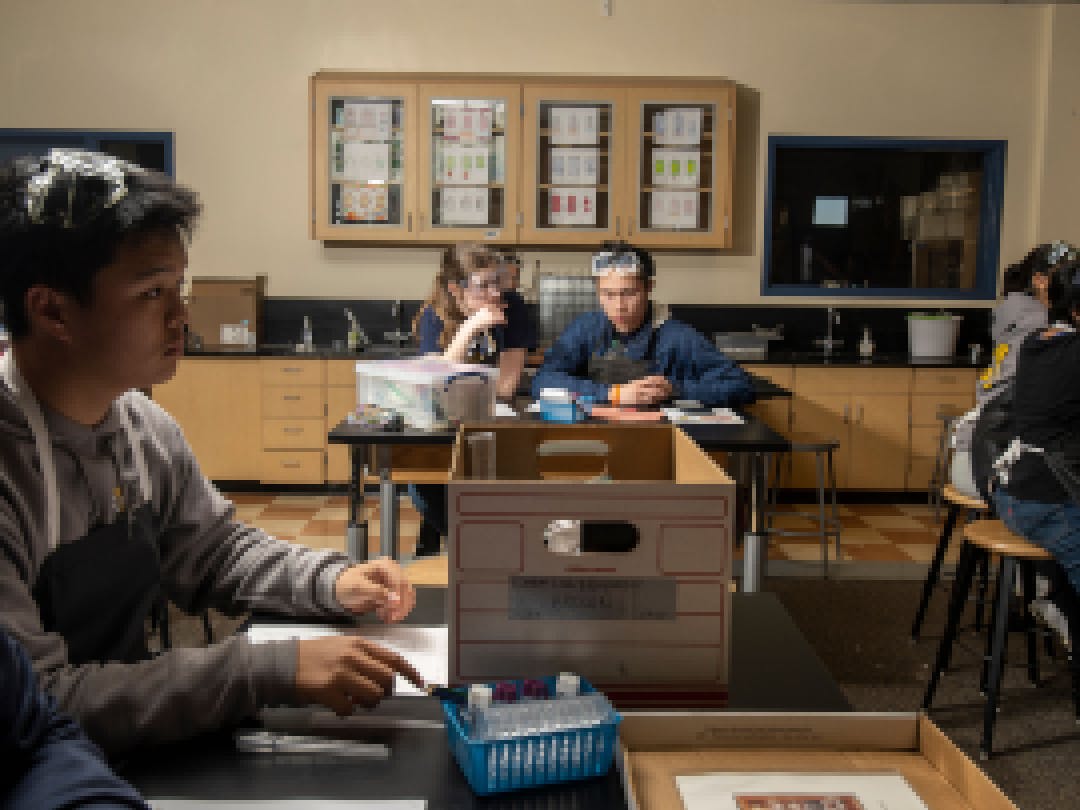
Ava, 18, and her partner Andrew, 17, wait for the beginning of Chem Lab at the Santa Clara County Regionals, where they ultimately took first place in the event.
When Ava started high school, she didn’t consider herself a science or math person — she was a creative writer. She joined Sci Oly because Meyer was previously her piano teacher and “she was always talking about the team.” This year she served as one of three senior captains. She still writes — long-form adventure and fantasy — but after four years on the team, she says, “you realize you are also a STEM person, using a broad, very powerful span of knowledge that covers more than one discipline.”
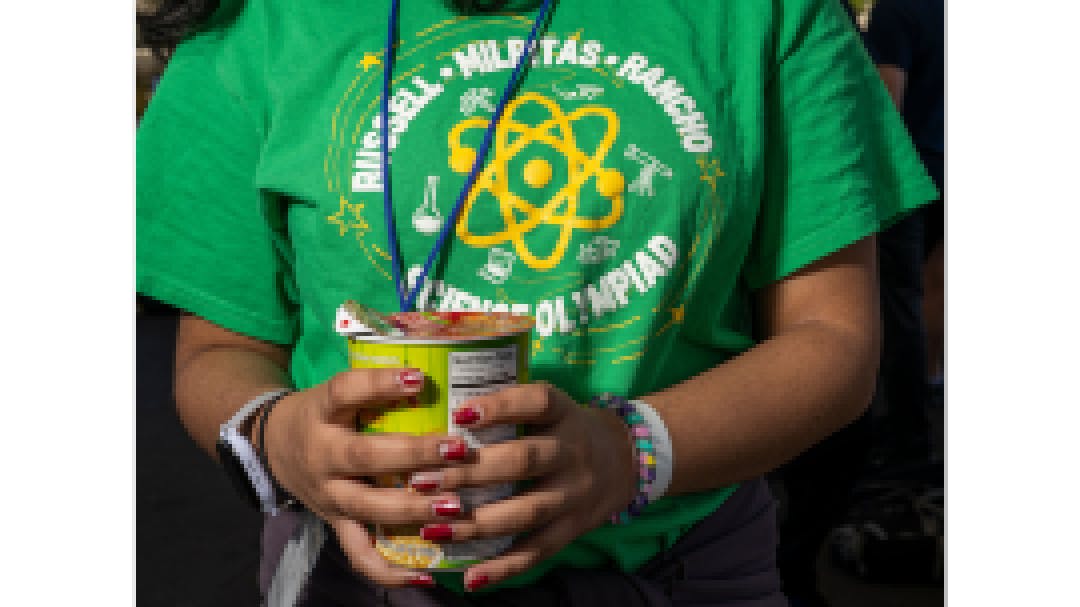
Thomas Russell Middle School is one of two middle schools that feed into Milpitas High — their Science Olympiad team wears green team shirts instead of the blue of the older students. Middle school is an important place for young people to start getting into STEM, but high school is where it really starts to lock in for most.
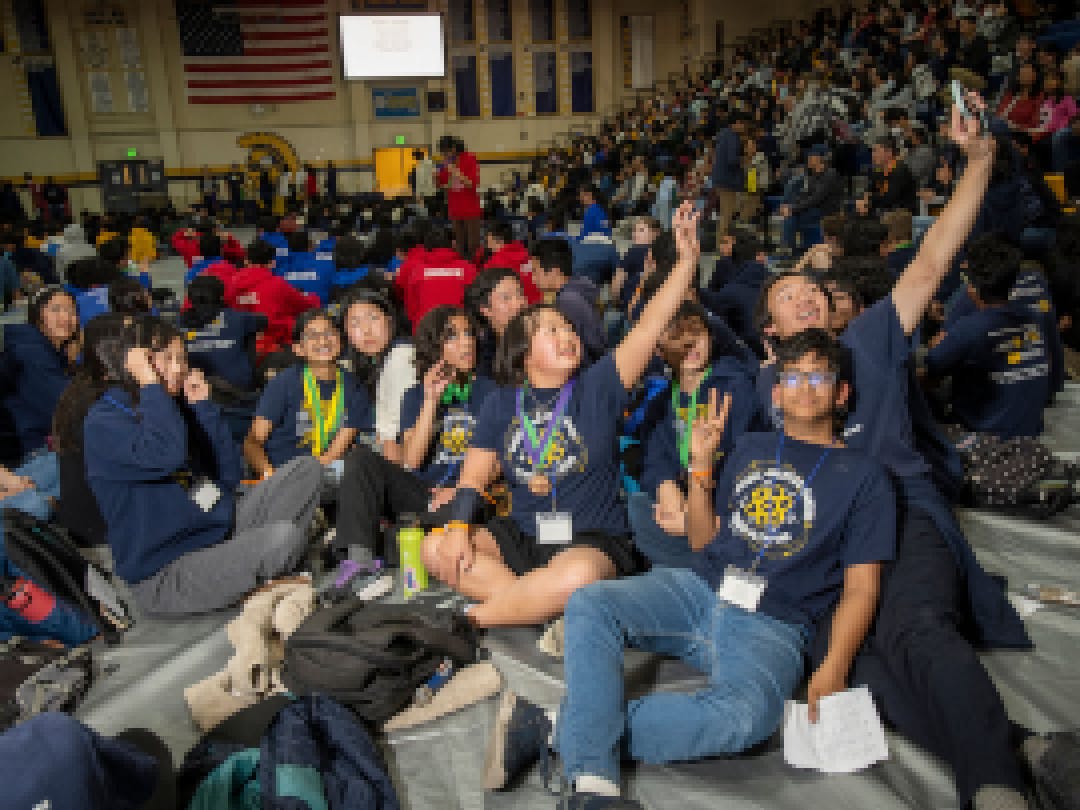
The team takes a selfie together during the awards ceremony at the end of Santa Clara County Regionals. Many of the students say the group feels like a close-knit family. In Meyer’s dissertation, she notes charter buses as an crucial, underrated item in the budget, because the long rides to competitions help bond the teammates as a community.
After the season ended in a fifth place finish, Meyer says, “I told them that results — good or bad — don’t define us. It’s how we perform over the entire season. And it’s not like things end. We are hosting an elementary tournament and choosing new captains. A lot of them are already talking about what they want to do next year.”
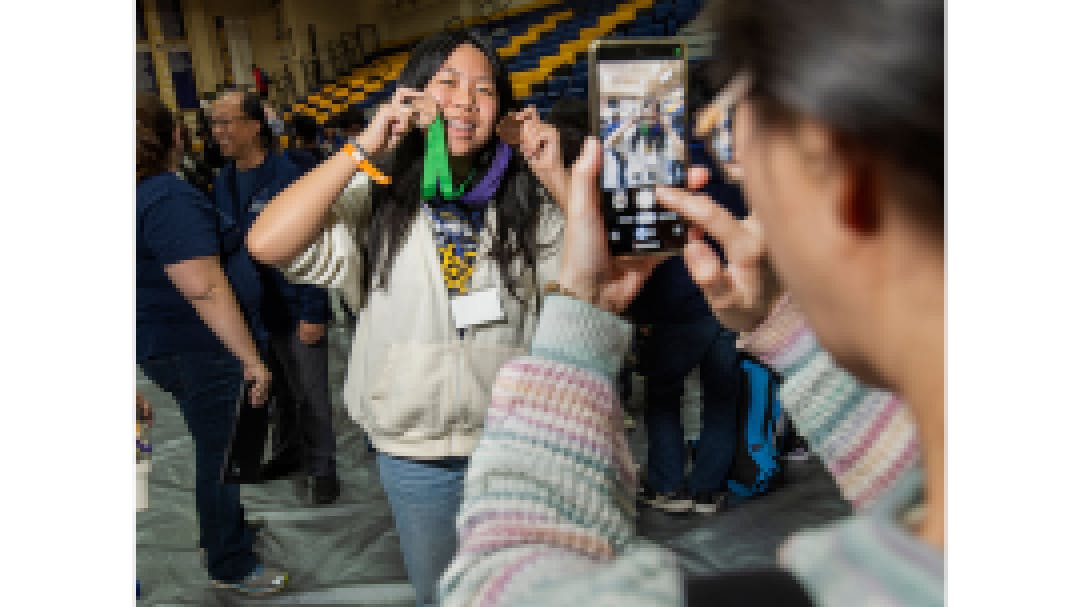
Brianna, 14, shows medals she won in Flight and Tower at the Santa Clara County Regionals as her mother, Liya Yang, takes a photo. Yang, a biology lab lecturer at the University of California, Berkeley, feels that pursuing specific research left her own career path very narrow, so she is glad that Brianna is getting wider, more practical experience in Science Olympiad.
In a Zoom interview, Yang says she would like her daughter to study medicine, but Yang’s husband is pushing for engineering. Yang says, “Engineering is a male field. I’m not sure how comfortable she will be.”
Off-screen, Brianna’s voice cuts in: “I will be fine!”






